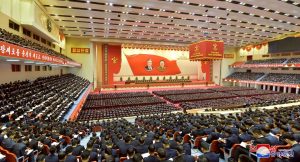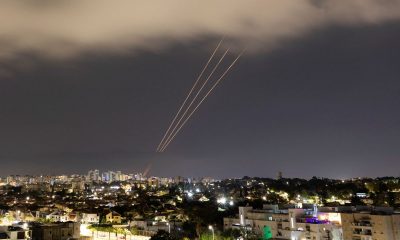Politics & Security
To Take Down North Korea, Think 2,000 Cruise Missiles
Published
6 years agoon

(Second of three parts)
Part 1: Do We Understand War? Japan Experts Discuss Realities of Confronting North Korea
As South and North Korea started their first official talks in two years, we run this series based on a panel discussion with two top-ranking members of the Japan Self-Defense Forces and journalists from the Sankei Shimbun and JAPAN Forward.
Yoji Koda, a retired vice admiral with the Japanese Maritime Self-Defense Force and a fellow at the Fairbank Center for Chinese Studies at Harvard, and Kunio Orita, the former head of the Air Self-Defense Force’s Air Support Command and a lecturer at Toyo Gakuen University, discuss what Japan, the United States, and South Korea could realistically do should war break out on the Korean Peninsula.

Possibilities of a Decapitation Strike
There is a widely-repeated and, actually somewhat probable, conspiracy theory: Soviet dictator Josef Stalin was assassinated by poison in 1953 by NKVD secret police chief Lavrentiy Beria in order to avoid Stalin’s drawing the Soviet Union into what Beria feared would be a devastating war against the United States.
Many people today—outside of North Korea as well as, surely, within—similarly hold out hope that Kim Jong-un will be put out of commission, thus avoiding war.
When asked during a Sankei Shimbun and JAPAN Forward panel discussion about this possibility, however, both former Japanese Maritime Self-Defense Force vice-admiral Yoji Koda and former Japanese Air Self-Defense Force Air Support Command leader Kunio Orita were circumspect, even sanguine.
“People in Japan tend to speak rather freely about a decapitation strike against Kim Jong-un,” Orita said. “But the reality is that the United States, at the present time, is not capable of carrying out such a stratagem.”

Former Japanese Air Self-Defense Force Air Support Command leader Kunio Orita
In a “closed society” such as North Korea, there would be no real possibility of obtaining the “precision information in real time” which is needed to track down and eliminate the North Korean leadership, Orita added.
Breaking Into Fortress Pyongyang
Also needed for a decapitation strike, Orita reminded the panel, was an exit strategy. Decapitation strikes are very delicate operations, the dead leader must be proven beyond all doubt to be dead, lest forces loyal to him go underground and attempt to wage war in his name by broadcasting false information that the leader is alive.
As in the strike against Osama bin Laden, Orita said, the dead leader must be killed in such a way as to preserve his physical recognizability. He must not be mutilated beyond photographic identification. In the event of a decapitation strike against the DPRK leader, the North Korean people must be convinced that Kim Jong-un is deceased and the Kim regime is over.
The United States, Orita continued, is currently unable to carry out such a strike against the North. According to Orita, the American Central Intelligence Agency (CIA) has sent some 2,000 operatives into North Korea, but none of them have reemerged to provide actionable intelligence.
As Koda added, Pyongyang is, perhaps, the most heavily fortified place on earth. From both operational and tactical standpoints, Koda said, a surgical strike against the North Korean leadership would be profoundly difficult.

Former Japanese Maritime Self-Defense Force vice-admiral Yoji Koda
A final obstacle to a decapitation strategy is China. Beijing would suffer the brunt of consequences from a regime-change strike against the North Korean leadership, as panicked refugees would likely stream across the China-North Korea border, seeking to avoid reprisals amid the chaos of a collapsing society.
At some level then, Chinese approval would be required for a decapitation strike against Pyongyang. This same would hold true, Orita continued, for any military action against the North.
The China Question
The US military is at a historically low troop level, while the Army, in particular, is stretched thinly across hundreds of bases in the US and abroad. United States Secretary of State Rex Tillerson has publicly indicated that he will not take land forces across the 38th parallel in the event of a war with North Korea. Orita said that this is likely because he cannot practically do so.
There is also the question of China. As Koda said, the Global Times, the English-language arm of the Chinese Communist Party mouthpiece People’s Daily (Renmin Ribao), began hinting in October of 2016 that the Chinese government might be willing to acquiesce to an American attack as long as there was no regime change in Pyongyang.

And in September of 2017, during the vote on the United Nations resolution to impose tough sanctions on North Korea, Liu Jieyi, China’s permanent representative to the United Nations, spoke of four conditions for any military action against the DPRK: no regime change, no elimination of the current regime, no American forces crossing the 38th parallel, and no speeding up the reunification of North and South Korea.
Koda believes Ambassador Liu was referring to land forces when he spoke of no American forces crossing into North Korea. All of this, Koda asserts, stems from China’s desire to preserve the North as a buffer zone between Chinese territory and a democratic country.
‘Photo Missions’
The media often broadcasts images of American, South Korean, and Japanese forces conducting drills and missions. For Orita, Koda, and other military professionals, these exercises are known as “photo missions.” They have no real tactical or strategic significance, but are designed as diplomatic showpieces for demonstrating superior firepower to an aggressive enemy.

These theatrics notwithstanding, the question remains: What kind of action is likely to be directed against North Korea, in the event that war does in fact break out on the Korean Peninsula?
Koda broadly envisions a scenario in which the US president orders the military to take out North Korea’s nuclear and missile capabilities in order to minimize, as much as possible, the loss of innocent life among civilian populations. Koda cited United States Secretary of Defense James Mattis, who has said that a plan is in place for protecting civilians and minimizing damage.
Surprise, Timing, and Air Superiority
For Koda, the key will be a “100% surprise attack” against the North, involving a concentrated volley of 1,500 to 2,000 cruise missiles. Even underground forces hiding out in hardened bunkers are vulnerable due to there being entrances, exits, and ventilation holes in such compounds. If bunker buster bombs failed to crush the underground tunnels completely, cruise missiles could still destroy access to the underground facilities, rendering them inoperable for at least a day, Koda said.
In any event, timing will be crucial to the success of such a plan, Koda continued. And for this to happen, it would be best if the US independently warred against the DPRK without the involvement of South Korea.

As stated earlier, there is a debate under the new South Korean president about whether to allow the US to command South Korean forces in the event of a war with the North. Under such unfavorable political circumstances, it would be to the American advantage to act alone, with South Korean and American forces continuing to cooperate in defense of the 38th parallel according to pre-existing plans.
Even in the event of a surprise attack, however, Orita pointed out that on the first day alone the US would have to fly between 2,000 and 2,600 sorties in order to take out the estimated 500 to 600 nodes (defense strongholds and vital positions) within North Korea. This is assuming an average of around four strikes being needed to suppress each node, which was the case during the Gulf War.
It is important to remember, though, Orita noted, that an aircraft carrier can launch a maximum of around 150 sorties per day. Even with five carriers working at full capacity, Orita said, it would be impossible to launch the number of sorties that would be required to take out North Korea’s air defenses at the rate needed to realize the American plan to minimize civilian casualties and damage.
Because of this, Guam and Japan would be vitally important to American forces for launching airstrikes against the North, especially in the opening days of a potential war.
(To be continued)

Jason Morgan is an assistant professor at Reitaku University in Chiba, Japan. He holds a PhD in Japanese legal history from the University of Wisconsin, and an MA in Asian Studies (China focus) from the University of Hawai’i. He has translated works by Mizoguchi Yuzo, Tanizaki Jun’ichiro, and Muro Saisei. In 2014-2015, Morgan was a Fulbright scholar researching Japanese law at Waseda University in Tokyo. His book, Why do Americans Look Down on Japan?, was published with Wani Books in 2016.
You may like
-


New Podcast Series: Abducted – Four Stories, Four Lives
-


Is It Time to Buy Bitcoin as the Yen Weakens?
-


North Korean Abductions: Victims' Families Urgent Appeal in Meeting with UN Ambassador Linda Thomas-Greenfield
-


EDITORIAL | With Attack on Israel, Iran Pushes for Wider Mideast War
-


EDITORIAL | Caution In South Korea as Smear Tactics Prevail in Election
-


INTERVIEW | Kim Yung-ho is Seoul's Forward-Thinking Unification Minister
















You must be logged in to post a comment Login